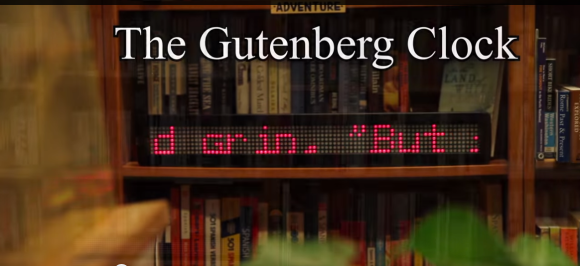We’ve seen a wide variety of hacks that keep time, but [ch00f]’s latest build takes a new spin on counting the seconds. The Gutenberg Clock keeps time by reading books on a scrolling LED screen.
The content for the clock is sourced from the Project Gutenberg, which releases books with expired copyright for free. The library on the clock consists of around twenty thousand such books. Read at eighty words per minute, the clock won’t repeat a passage for the next thirty-three years.
While the clock doesn’t display time itself, it is synchronized to time. Two identical clocks should display the same text at the same time. To get the time, [ch00f] first tried hacking apart a cheap radio clock, which is synchronized to NIST’s 60 kHz broadcast. After reverse engineering the protocol with great success, stray RF energy from the display turned out to cause too much interference.
With the cheap solution out the window, [ch00f] built a custom breakout for an Adafruit GPS module and used it to get the time. This was his first RF board, but it worked out fine.
Books are loaded onto a FAT filesystem on an SD card, and [ChaN]’s FatFS is used to interpret the filesystem. A microcontroller then sends the text out at a constant rate to a serial port on the display which he hacked his way into.
The project is a neat mix of art and electronics. Stick around for a video overview after the break.















Just when I’ve thought I’ve seen the stupidest stuff imaginable something like this comes along to show me that I haven’t seen anything yet.
Yeah, the whole “clock hack” thing is the hardware version of “Hello World”.
That may be. But I learned a ton from my first clock build.
It just seems that this project thumbs its nose at everything it encompasses. Time keeping, and text. The beauty of text is that it is not time clocked, you start it when you want to. I suppose the beauty of time is that everything does not happen at once. I’m not sure how time enhances text though.
Next. Add text to speech.
http://www.digikey.com/product-search/en/integrated-circuits-ics/clock-timing-real-time-clocks/2556170?k=real%20time%20clock
Only 2190 hits
I think he’s referring to an WWVB NIST radio time receiver like the Sparkfun https://www.sparkfun.com/products/retired/10060
Allegedly the module has been discontinued.
Why do we need a device that displays words in the same order at the same rate forever and ever? You can’t even tell what time it is, so how is this supposed to be useful?
> so how is this supposed to be useful?
It’s not supposed to be useful.
With a light alteration to that LED display, it would be feasible to ‘Spritz’ (silly verbed name I admit,for an old idea) the words instead of scrolling them…. http://www.spritzinc.com which looks quite neat.
Am I the only one disappointed that it cuts off all the descenders?
In general, this is a good idea, but very specific hard- and software. Why not use standard hardware like Arduino and Dot Matrix modules based on Max7219 like this:
http://www.icstation.com/product_info.php?products_id=2609#.U-xg4Pl_tg0
http://www.embeddedadventures.com/LED_matrix_display_LDP-8008.html
Well, unlike the nattering nabobs above, I think this is incredibly cool. Dealing with commercial LED matrix signs always seems to involve some dirty hackery since they’re never well-documented or designed for this sort of integration, but that’s really not the point.
The point is that this device starts conversations. It’s not meant to sit in your private lab and tell the time — it’s not really a clock in that sense. Put it in the study, put it in the family room, put it in a coffee shop or a gallery or a courthouse. It’s a reminder of how much time humans have spent writing down our thoughts, and how much time it would take to absorb them all. This has already been shown to be impossible:
https://what-if.xkcd.com/76/
The irony is that ch00f’s project will, in fact, run out of material in just a few decades. Maybe by that time, copyright law will have been reformed and the next version will read for a millennium, or maybe it’ll just be stuck reading the same 29,000 out-of-copyright books forever, emphasizing how *modern* human knowledge is not as free as it once was. Even as the practical barriers to writing and distribution get almost infinitely low..
If you put it that way then it is a compelling piece of art. As it was presented here it kind of sucks though.
What a beautiful Idea. I love it. there really is something special about being able to look up and see words from books long ago have little to no clue what you may be reading. I could get lost staring at this. Great project.
But, this practice of purchasing used books requires conserving a lot of green in support of the surroundings.